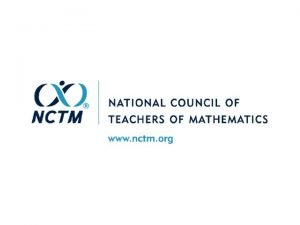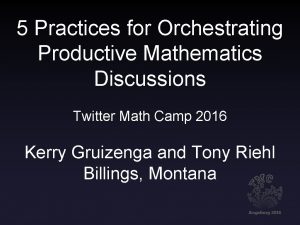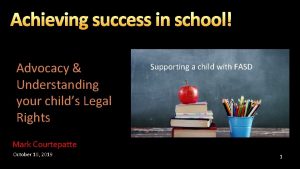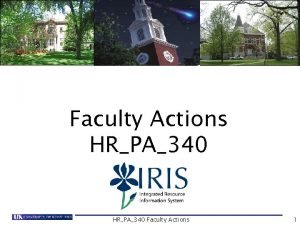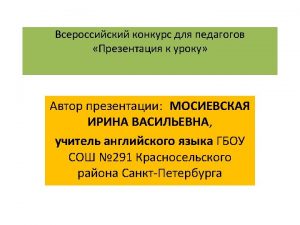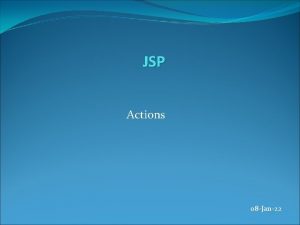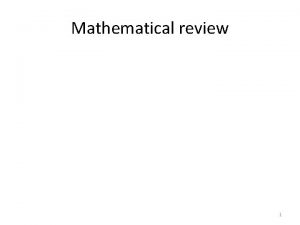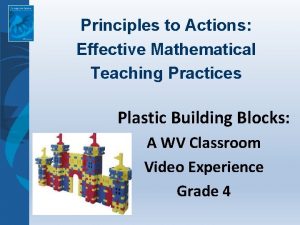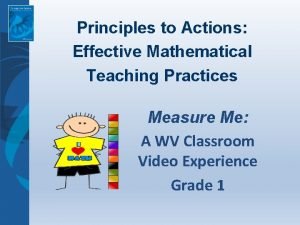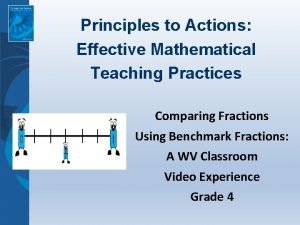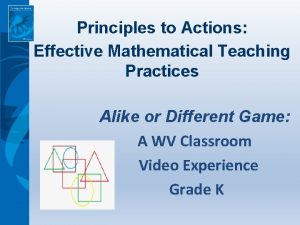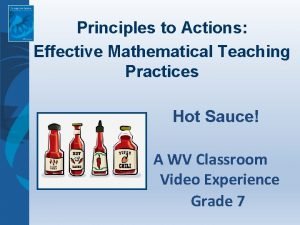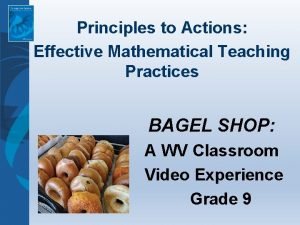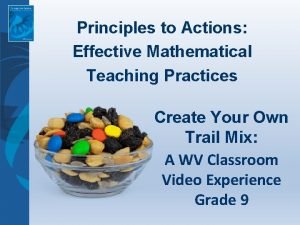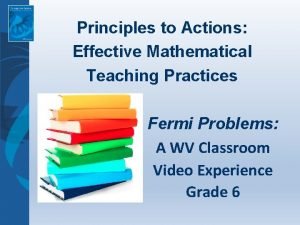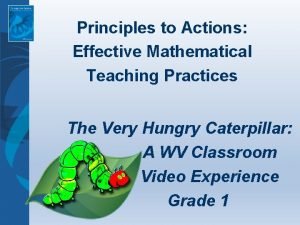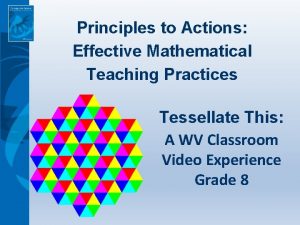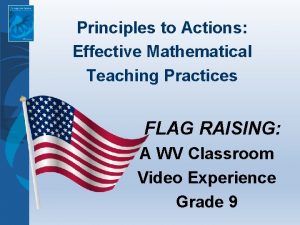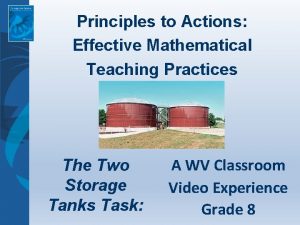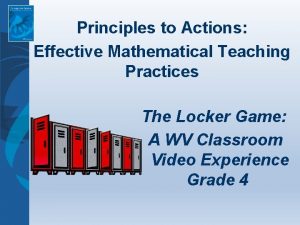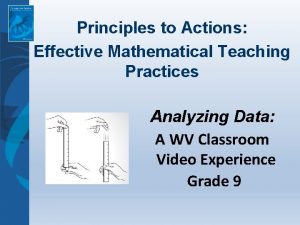Practices to Actions Ensuring Mathematical Success for All






























































- Slides: 62

Practices to Actions: Ensuring Mathematical Success for All A Focus on Effective Mathematics Teaching Practices “Mr. Harris and the Band Concert Task” Developed by: Dr. De. Ann Huinker, University of Wisconsin–Milwaukee

Agenda • • Examine the purpose and key messages of NCTM’s Principles to Actions. Read a case of a third-grade teacher using the Band Concert Task with his students. Discuss the set of eight mathematics teaching practices and relate them to the case. Reflect on next steps in strengthening these teaching practices in your own instruction.

Principles to Actions

Principles to Actions: Ensuring Mathematical Success for All The primary purpose of Principles to Actions is to fill the gap between the adoption of rigorous standards and the enactment of practices, policies, programs, and actions required for successful implementation of those standards.

Teaching and Learning Access and Equity Guiding Principles for School Mathematics Curriculum Tools and Technology Assessment Professionalism

Overarching Message “Effective teaching is the non-negotiable core that ensures that all students learn mathematics at high levels. ” Principles to Actions (NCTM, 2014, p. 4)

Why Focus on Teaching? Student learning of mathematics “depends fundamentally on what happens inside the classroom as teachers and learners interact over the curriculum. ” (Ball & Forzani, 2011, p. 17) Ball, D. L, & Forzani, F. M. (2011). Building a common core for learning to teach, and connecting professional learning to practice. American Educator, 35(2), 17 -21.

Teaching and Learning Principle “An excellent mathematics program requires effective teaching that engages students in meaningful learning through individual and collaborative experiences that promote their ability to make sense of mathematical ideas and reason mathematically. ” Principles to Actions (NCTM, 2014, p. 7)

Effective Mathematics Teaching Practices

High-Leverage, Effective Mathematics Teaching Practices “Those practices at the heart of the work of teaching that are most likely to affect student learning. ” (Ball & Forzani, 2010, p. 45) Ball, D. L, & Forzani, F. M. (2010). Teaching skillful teaching. Educational Leadership, 68(4), 40 -45.

Effective Mathematics Teaching Practices 1. Establish mathematics goals to focus learning. 2. Implement tasks that promote reasoning and problem solving. 3. Use and connect mathematical representations. 4. Facilitate meaningful mathematical discourse. 5. Pose purposeful questions. 6. Build procedural fluency from conceptual understanding. 7. Support productive struggle in learning mathematics. 8. Elicit and use evidence of student thinking.

Effective Mathematics Teaching Practices 1. Establish mathematics goals to focus learning. 2. Implement tasks that promote reasoning and problem solving. 3. Use and connect mathematical representations. 4. Facilitate meaningful mathematical discourse. 5. Pose purposeful questions. 6. Build procedural fluency from conceptual understanding. 7. Support productive struggle in learning mathematics. 8. Elicit and use evidence of student thinking.

Task The Band Concert

The Band Concert Make a sketch or diagram of the situation that The third-grade class is responsible for setting might be used by up the chairs for their spring band concert. Grade 3 students. In preparation, they need to determine the total number of chairs that will be needed Discuss potential and ask the school’s engineer to retrieve that approaches and many chairs from the central storage area. struggles. The class needs to set up 7 rows of chairs with 20 chairs in each row, leaving space for a center aisle. How many chairs does the school’s engineer need to retrieve from the central storage area?

Math Goals Tasks & Representations What might be the math learning goals? What representations might students use in reasoning through and solving the problem? Discourse & Questions How might we question students and structure class discourse to advance student learning? Fluency from Understanding How might we develop student understanding to build toward aspects of procedural fluency? Struggle & Evidence How might we check in on student thinking and struggles and use it to inform instruction?

Case of Mr. Harris and the Band Concert Task

The Case of Mr. Harris and the Band Concert Task IS ARR H. MR • Read the Case of Mr. Harris and study the strategies used by his students. • Make note of what Mr. Harris did before or during instruction to support his students’ developing understanding of multiplication. • Talk with a neighbor about the “Teaching Practices” Mr. Harris is using and how they support students’ progress in their learning.

Relating the Mathematics Teaching Practices to the Case

Math Teaching Practice 1 Establish mathematics goals to focus learning. Formulating clear, explicit learning goals sets the stage for everything else. (Hiebert, Morris, Berk, & Janssen, 2007, p. 57)

Establish mathematics goals to focus learning Learning Goals should: • Clearly state what it is students are to learn and understand about mathematics as the result of instruction. • Be situated within learning progressions. • Frame the decisions that teachers make during a lesson. Daro, Mosher, & Corcoran, 2011; Hattie, 2009; Hiebert, Morris, Berk, & Jensen. , 2007; Wiliam, 2011

Mr. Harris’s Math Goals Students will recognize the structure of multiplication as equal groups within and among different representations, focusing on identifying the number of equal groups and the size of each group within collections or arrays. Student-friendly version. . . We are learning to represent and solve word problems and explain how different representations match the story situation and the math operations.

Alignment to the Common Core State Standards Standard 3. OA. 3. Use multiplication and division within 100 to solve word problems in situations involving equal groups, arrays, and measurement quantities, e. g. , by using drawings and equations with a symbol for the unknown number to represent the problem. -------------------------------Standard 3. NBT. 3. Multiply one-digit whole numbers by multiples of 10 in the range 10– 90 (e. g. , 9 x 80, 5 x 60) using strategies based on place value and properties of operations.

Questions What were the math expectations for student learning? In what ways did these math goals focus the teacher’s interactions with students throughout the lesson? Consider Case Lines 4 -9, 21 -24, 27 -29.

Math Teaching Practice 2 Implement tasks that promote reasoning and problem solving. Student learning is greatest in classrooms where the tasks consistently encourage high-level student thinking and reasoning and least in classrooms where the tasks are routinely procedural in nature. (Boaler & Staples, 2008; Stein & Lane, 1996)

Implement tasks that promote reasoning and problem solving Mathematical tasks should: • Allow students to explore mathematical ideas or use procedures in ways that are connected to understanding concepts. • Build on students’ current understanding and experiences. • Have multiple entry points. • Allow for varied solution strategies. Boaler & Staples, 2008; Hiebert et al. , 1997; Stein, Smith, Henningsen, & Silver, 2009

Questions In what ways did the implementation of the task allow for multiple entry points and engage students in reasoning and problem solving? Consider Case Lines 26 -30 & 38 -41.

Math Teaching Practice 3 Use and connect mathematical representations. Because of the abstract nature of mathematics, people have access to mathematical ideas only through the representations of those ideas. (National Research Council, 2001, p. 94)

Use and connect mathematical representations Different Representations should: • Be introduced, discussed, and connected. • Be used to focus students’ attention on the structure of mathematical ideas by examining essential features. • Support students’ ability to justify and explain their reasoning. Lesh, Post, & Behr, 1987; Marshall, Superfine, & Canty, 2010; Tripathi, 2008; Webb, Boswinkel, & Dekker, 2008

Important Mathematical Connections between and within different types of representations Visual Physical Symbolic Contextual Principles to Actions (NCTM, 2014, p. 25) (Adapted from Lesh, Post, & Behr, 1987) Verbal

What mathematical representations were students working with in the lesson? Physical How did Mr. Harris support students in making connections between and within different types of Contextual representations? Visual Symbolic Verbal

Consider Lines 43 -48. In what ways did comparing representations strengthen the understanding of these students? Jasmine Kenneth

Consider Lines 48 -49. How did comparing representations benefit Molly? Molly

Math Teaching Practice 4 Facilitate meaningful mathematical discourse. Discussions that focus on cognitively challenging mathematical tasks, namely those that promote thinking, reasoning, and problem solving, are a primary mechanism for promoting conceptual understanding of mathematics. (Hatano & Inagaki, 1991; Michaels, O’Connor, & Resnick, 2008)

Facilitate meaningful mathematical discourse Mathematical Discourse should: • Build on and honor students’ thinking. • Let students share ideas, clarify understandings, and develop convincing arguments. • Engage students in analyzing and comparing student approaches. • Advance the math learning of the whole class. Carpenter, Franke, & Levi, 2003; Fuson & Sherin, 2014; Smith & Stein, 2011

Questions How did Mr. Harris structure the whole class discussion (lines 52 -57) to advance student learning toward the intended math learning goals?

How does each representation match the story Consider Lines 52 -57. Why did Mr. Harris select and sequence the work of these situation and the structure of multiplication? three students and how did that support student learning? Jasmine Kenneth Teres a

Structuring Mathematical Discourse. . . During the whole class discussion of the task, Mr. Harris was strategic in: • Selecting specific student representations and strategies for discussion and analysis. • Sequencing the various student approaches for analysis and comparison. • Connecting student approaches to key math ideas and relationships.

1. Anticipating 2. Monitoring 3. Selecting 4. Sequencing 5 Practices for Orchestrating Productive Mathematics Discussions 5. Connecting (Smith & Stein, 2011)

Math Teaching Practice 5 Pose purposeful questions. Teachers’ questions are crucial in helping students make connections and learn important mathematics and science concepts. (Weiss & Pasley, 2004)

Pose purposeful questions Effective Questions should: • Reveal students’ current understandings. • Encourage students to explain, elaborate, or clarify their thinking. • Make the targeted mathematical ideas more visible and accessible for student examination and discussion. Boaler & Brodie, 2004; Chapin & O’Connor, 2007; Herbel-Eisenmann & Breyfogle, 2005

Questions In what ways did Mr. Harris’ questioning on lines 33 -36 assess and advance student learning about important mathematical ideas and relationships?

Purposeful Questions Lines 33 -36 “How does your drawing show 7 rows? ” “How does your drawing show that there are 20 chairs in each row? “How many twenties are you adding, and why? ” “Why are you adding all those twenties? Math Learning Goal Students will recognize the structure of multiplication as equal groups within and among different representations —identify the number of equal groups and the size of each group within collections or arrays.

Math Teaching Practice 6 Build procedural fluency from conceptual understanding. A rush to fluency undermines students’ confidence and interest in mathematics and is considered a cause of mathematics anxiety. (Ashcraft 2002; Ramirez Gunderson, Levine, & Beilock, 2013)

Build procedural fluency from conceptual understanding Procedural Fluency should: • Build on a foundation of conceptual understanding. • Over time (months, years), result in known facts and generalized methods for solving problems. • Enable students to flexibly choose among methods to solve contextual and mathematical problems. Baroody, 2006; Fuson & Beckmann, 2012/2013; Fuson, Kalchman, & Bransford, 2005; Russell, 2006

Questions In what ways did this lesson develop a foundation of conceptual understanding for building toward procedural fluency in multiplying with multiples of ten?

Questions What foundational understandings were students developing at each of these points in the lesson that are critical for moving toward procedural fluency? Lines 59 -69: Discussion of skip counting. Lines 70 -76: Wrote the multiplication equation. Lines 78 -81: Asked students to compare Tyrell and Ananda’s work.

Discuss ways to use this student work to develop the understanding that 14 tens = 140 and to meaningfully to build toward fluency in working with multiples of ten. Tyrell Ananda

Discuss ways to use this student work to develop informal ideas of the distributive property—how numbers can be decomposed, combined meaningfully in parts, and then recomposed to find the total. Tyrell Ananda

“Fluency builds from initial exploration and discussion of number concepts to using informal reasoning strategies based on meanings and properties of the operations to the eventual use of general methods as tools in solving problems. ” Principles to Actions (NCTM, 2014, p. 42)

Math Teaching Practice 7 Support productive struggle in learning mathematics. The struggle we have in mind comes from solving problems that are within reach and grappling with key mathematical ideas that are comprehendible but not yet well formed. (Hiebert, Carpenter, Fennema, Fuson, Human, Murray, Olivier, & Wearne, 1996)

Support productive struggle in learning mathematics Productive Struggle should: • Be considered essential to learning mathematics with understanding. • Develop students’ capacity to persevere in the face of challenge. • Help students realize that they are capable of doing well in mathematics with effort. Black, Trzesniewski, & Dweck, 2007; Dweck, 2008; Hiebert & Grouws, 2007; Kapur, 2010; Warshauer, 2011

Questions How did Mr. Harris support productive struggle among his students, individually and collectively, as they grappled with important mathematical ideas and relationships? At which points in the lesson might Mr. Harris have consciously restrained himself from “taking over” the thinking of his students?

Math Teaching Practice 8 Elicit and use evidence of student thinking. Teachers using assessment for learning continually look for ways in which they can generate evidence of student learning, and they use this evidence to adapt their instruction to better meet their students’ learning needs. (Leahy, Lyon, Thompson, & Wiliam, 2005, p. 23)

Elicit and use evidence of student thinking Evidence should: • Provide a window into students’ thinking. • Help the teacher determine the extent to which students are reaching the math learning goals. • Be used to make instructional decisions during the lesson and to prepare for subsequent lessons. Chamberlin, 2005; Jacobs, Lamb, & Philipp, 2010; Sleep & Boerst, 2010; van Es, 2010’ Wiliam, 2007

Questions Identify specific places during the lesson (cite line numbers) in which Mr. Harris elicited evidence of student learning. Discuss how he used or might use that evidence to adjust his instruction to support and extend student learning.

Examples of Eliciting and Using Evidence Throughout the lesson, Mr. Harris was eliciting and using evidence of student thinking. Lines 33 -36: Purposeful questioning as students worked individually. Lines 43 -51: Observations of student pairs discussing and comparing their representations. Lines 59 -74: Whole class discussion. Lines 78 -80: Asked students to respond in writing.

Reflections and Next Steps

NCTM’s Core Set of Effective Mathematics Teaching Practices “Although the important work of teaching is not limited to the eight Mathematics Teaching Practices, this core set of research-informed practices is offered as a framework for strengthening the teaching and learning of mathematics. ” Principles to Actions (NCTM, 2014, p. 57)

Effective Mathematics Teaching Practices 1. Establish mathematics goals to focus learning. 2. Implement tasks that promote reasoning and problem solving. 3. Use and connect mathematical representations. 4. Facilitate meaningful mathematical discourse. 5. Pose purposeful questions. 6. Build procedural fluency from conceptual understanding. 7. Support productive struggle in learning mathematics. 8. Elicit and use evidence of student thinking.

Development As you reflect on this framework for the teaching and learning of mathematics, identify 1 -2 mathematics teaching practices that want to begin strengthening in your own instruction. Working with a partner, develop a list of actions to begin the next steps of your journey toward ensuring mathematical success for all of your students.

Thank You! Dr. De. Ann Huinker University of Wisconsin–Milwaukee huinker@uwm. edu 02. 17. 15

 Principles to actions ensuring mathematical success for all
Principles to actions ensuring mathematical success for all Econ213
Econ213 5 practices for orchestrating mathematical discussions
5 practices for orchestrating mathematical discussions Your child's success or lack of success
Your child's success or lack of success Your child's success or lack of success
Your child's success or lack of success Name three lines
Name three lines Kontinuitetshantering
Kontinuitetshantering Typiska drag för en novell
Typiska drag för en novell Tack för att ni lyssnade bild
Tack för att ni lyssnade bild Vad står k.r.å.k.a.n för
Vad står k.r.å.k.a.n för Varför kallas perioden 1918-1939 för mellankrigstiden
Varför kallas perioden 1918-1939 för mellankrigstiden En lathund för arbete med kontinuitetshantering
En lathund för arbete med kontinuitetshantering Kassaregister ideell förening
Kassaregister ideell förening Vilotidsbok
Vilotidsbok A gastrica
A gastrica Densitet vatten
Densitet vatten Datorkunskap för nybörjare
Datorkunskap för nybörjare Boverket ka
Boverket ka Debatt artikel mall
Debatt artikel mall För och nackdelar med firo
För och nackdelar med firo Nyckelkompetenser för livslångt lärande
Nyckelkompetenser för livslångt lärande Påbyggnader för flakfordon
Påbyggnader för flakfordon Kraft per area
Kraft per area Svenskt ramverk för digital samverkan
Svenskt ramverk för digital samverkan Bo bergman jag fryser om dina händer
Bo bergman jag fryser om dina händer Presentera för publik crossboss
Presentera för publik crossboss Jiddisch
Jiddisch Vem räknas som jude
Vem räknas som jude Treserva lathund
Treserva lathund Epiteltyper
Epiteltyper Claes martinsson
Claes martinsson Centrum för kunskap och säkerhet
Centrum för kunskap och säkerhet Byggprocessen steg för steg
Byggprocessen steg för steg Mat för idrottare
Mat för idrottare Verktyg för automatisering av utbetalningar
Verktyg för automatisering av utbetalningar Rutin för avvikelsehantering
Rutin för avvikelsehantering Smärtskolan kunskap för livet
Smärtskolan kunskap för livet Ministerstyre för och nackdelar
Ministerstyre för och nackdelar Tack för att ni har lyssnat
Tack för att ni har lyssnat Vad är referatmarkeringar
Vad är referatmarkeringar Redogör för vad psykologi är
Redogör för vad psykologi är Matematisk modellering eksempel
Matematisk modellering eksempel Tack för att ni har lyssnat
Tack för att ni har lyssnat Borra hål för knoppar
Borra hål för knoppar Orubbliga rättigheter
Orubbliga rättigheter Varians formel
Varians formel Tack för att ni har lyssnat
Tack för att ni har lyssnat Steg för steg rita
Steg för steg rita Verksamhetsanalys exempel
Verksamhetsanalys exempel Tobinskatten för och nackdelar
Tobinskatten för och nackdelar Blomman för dagen drog
Blomman för dagen drog Modell för handledningsprocess
Modell för handledningsprocess Egg för emanuel
Egg för emanuel Elektronik för barn
Elektronik för barn Plagg i rom
Plagg i rom Strategi för svensk viltförvaltning
Strategi för svensk viltförvaltning Var 1721 för stormaktssverige
Var 1721 för stormaktssverige Ellika andolf
Ellika andolf Ro i rom pax
Ro i rom pax Tack för att ni lyssnade
Tack för att ni lyssnade Multiplikation med decimaltal uppgifter
Multiplikation med decimaltal uppgifter Dikt om ljus
Dikt om ljus Inköpsprocessen steg för steg
Inköpsprocessen steg för steg
